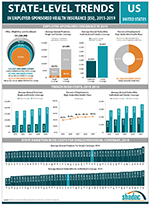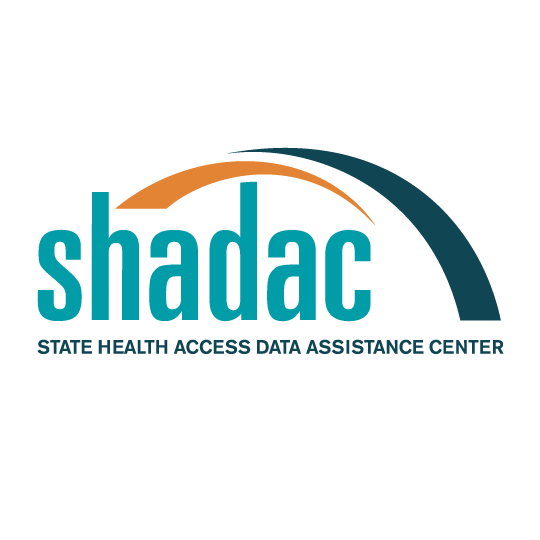Blog & News
Employer-Sponsored Insurance, 2015-2019: Premiums Hit New Highs and Deductibles Resume Increases after Brief Plateau (Infographic)
September 10, 2020:More than 62.5 million private sector workers in the United States received health insurance benefits from their employer in 2019, and, according to SHADAC researchers, paid higher-than-ever premiums for their health plans last year. Using data from the Medical Expenditure Panel Survey-Insurance Component (MEPS-IC), a new analysis from SHADAC highlights the experiences of private sector workers with employer-sponsored insurance (ESI) from 2015 through 2019 at the national level and within the states.
- The national average annual single-coverage premium rose by $257, or 3.8 percent, to $6,972 in 2019.
- Premium increases for single coverage were also seen in seven states (Alabama, California, Delaware, Maine, North Carolina, Tennessee, and Vermont), and no state saw a significant decrease in single coverage premiums.
- In 2019, the average annual family-coverage premium nationwide rose by $921 to $20,486—a 4.7 percent increase from 2018.
- Family premiums for ESI also increased in 10 states, with no significant state-level decreases seen.
Deductibles
- The national average annual single-coverage deductible increased to $1,931 in 2019, rising 4.6 percent from $1,846 the year before.
- Among the states, eight saw increases in average deductibles for single coverage while just one state (Pennsylvania) saw a significant decrease.
- The 2019 average annual family-coverage deductible also increased to $3,655, or 7.8 percent, from $3,392 in 2018.
- Seven states also saw their annual deductibles for family coverage increase in 2019; however, no states saw a significant decrease.
High-Deductible Health Plan Enrollment
- In 2019, half of private-sector employees nationwide who had ESI (50.5 percent) were enrolled in a high-deductible health plan (HDHP), a rate that was statistically unchanged from 2018 (49.1 percent) but that is 11.1 percentage points higher than in 2015 (39.4 percent).1
Coverage
- Nationwide, the percentage of employers offering health insurance coverage remained steady at 47.4 percent in 2019.
- This offer extends to the majority of private-sector employees - in 2019, 85.3 percent of employees worked in establishments that offer health insurance coverage.
- Employee eligibility for employer-sponsored insurance held steady as well, at 77.7 in 2019.
- The percent of eligible U.S. employees enrolled in health coverage through ESI also saw no significant change between 2018 and 2019—registering at 71.9 percent in 2019.
The Takeaway
As the majority of the United States population continues to receive health insurance coverage from their employer, it is important to remember that trends in ESI data such as rising premiums and continuing high enrollment in HDHPs affect a significant number of people. And while 2018 saw a plateau in deductible growth, 2019 once again saw increases in both single and family deductibles, with SHADAC’s State Health Compare estimates confirming an overall trend in rising deductibles for employer-sponsored insurance more than doubling nationwide over the past 10 years.
Explore the Analysis
The following products present detailed findings from this analysis:
Average Single and Family Premiums, 2019
Interactive Map: Hover over a state on the map below to view the average single- and family-coverage premiums in 2019, or click a state to view and download its individual state profile.


 For more detailed information on ESI findings from SHADAC, see the following products:
For more detailed information on ESI findings from SHADAC, see the following products:
- Report Narrative highlighting key findings on levels of, and trends in: average ESI premiums and deductibles as well as employee access to and take-up of ESI coverage
- Two-page profiles on ESI trends for each state
- 50-state comparison tables 2015-2019 ESI data
Related Resources
SHADAC Blog
Now Available on State Health Compare: 12 Updated and New Measures on Health Insurance Coverage, Cost of Care, Public Health, Health Behaviors and Outcomes, and Quality of Care
SHADAC ESI Report (2019)
Employer-Sponsored Health Insurance at the State Level, 2014-2018
SHADAC ESI Blog (2019)
Employer-Sponsored Insurance, 2014-2018: Premiums Reach New Heights while Deductibles Hold Steady
1 For the purposes of this analysis, high-deductible health plans are defined as plans that meet the minimum deductible amount required for Health Savings Account (HSA) eligibility ($1,350 for an individual and $2,700 for a family in 2019). This includes employees enrolled in single- and family-coverage plans.










